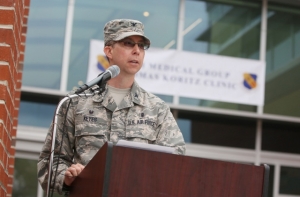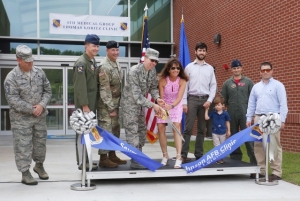Seymour Johnson Air Force Base opens Thomas Koritz Clinic
By Joey Pitchford
Published in News on June 17, 2018 3:05 AM

News-Argus/CASEY MOZINGO
Col. Craig Keyes, Medical Facility commander, speaks during the ribbon cutting Friday, thanking key people who made the new facility possible.

News-Argus/CASEY MOZINGO
Col. Christopher Sage, commander of the 4th Fighter Wing, Lt. Col. John Grabowski of the Army Corps of Engineers, Col. Craig Keyes, Medical Facility commander, and members of the Koritz family cut the ribbon for the Thomas Koritz Clinic Friday morning.
After a decade of waiting, medical staff on Seymour Johnson Air Force Base have some shiny new accommodations, as the base held a ribbon cutting ceremony for the new Thomas Koritz replacement medical clinic Friday.
The new clinic, which bears the name of a celebrated F-15E Strike Eagle pilot and medical doctor who was killed in Iraq during Operation Desert Storm, was first conceptualized around 10 years ago, said 4th Medical Group Commander Col. Craig Keyes. After all of the preliminary planning was completed, construction took around four years, he said, culminating in the Friday event.
The new building will allow SJAFB medics, both in the 4th Medical Group and the 916th Aerospace Medicine Squadron, to operate more efficiently, Keyes said.
"A large part of this is energy efficiency and staff and patient efficiency," he said. "We moved from an old hospital that was designed for inpatient care. It is now a very quick and easy process for patients to get in and get out. It's very efficient for our staff, instead of having to walk 100 feet, now they're walking 25 feet because everything is condensed and consolidated."
Keyes was one of several speakers during the ribbon cutting, including 4th Fighter Wing Commander Col. Christopher Sage, Army Corps of Engineers Lt. Col. John Grabowski and Lt. Col. Tomas Jaime.
Grabowski discussed the physical characteristics of the clinic, including the design elements which make it unique. The clinic has a familiar look to the rest of the base, with a primarily brick façade, but draws aesthetic inspiration from both the Wright Brothers' first mechanized flying machine made of wood and fabric and modern aircraft like the F-15E.
As viewed from Wright Brothers Avenue on base, the building has a gently sloping roof made of metal, which follows the contour of an F-15 wing. As the roof reaches its highest point, it switches to a translucent skylight covered with a weather-resistant, woven fabric, which evokes the look of those early airplanes created by the Wright Brothers.
The look of the building is not the only aspect of it to carry history and memory.
During his speech, Jaime discussed the history behind the facility's name.
Maj. Thomas "Teek" Koritz was both an experienced medical doctor and a skilled F-15E pilot, a rarity in the Air Force. When he first applied to be a pilot, Koritz was told that being a doctor meant he could only fly as a non-crew member, Jaime said. That didn't sit well with Koritz, for whom flying was one of his great loves, and so later he applied again, this time only letting slip that he had an advanced degree of some sort. Koritz excelled as a pilot, later landing a spot with the 335th Fighter Squadron at Seymour Johnson Air Force Base.
On Jan. 16, 1991, Koritz and his back-seater Lt. Col. Donnie Holland were shot down by Iraqi anti-aircraft fire after a successful bombing mission in Basrah. Both the old medical clinic and now the new one, bear his name in memory of his service and his commitment to Air Force medicine.
Koritz's wife, Julie, and his three sons, Timothy, John and Scott, attended the ribbon cutting. After helping Keyes cut the ribbon, Julie Koritz took to the podium to remember her husband.
"I think Teek would be so excited to see something of this nature, because there's one thing that he loved to do and that is to fly," she said. "He also loved to help people, he liked to make them healthy."
Koritz asked that, whenever the airmen in attendance were feeling stressed or angry, to think of Teek and how he used humor to lighten tense situations.
"I hope when all of you are in a crunch and everything is crazy and you're all ready to tear your hair out with everything that's going on, just turn around and smile and giggle," she said. "And think of Teek, because that's exactly what he would've done. He would've cracked a joke."
